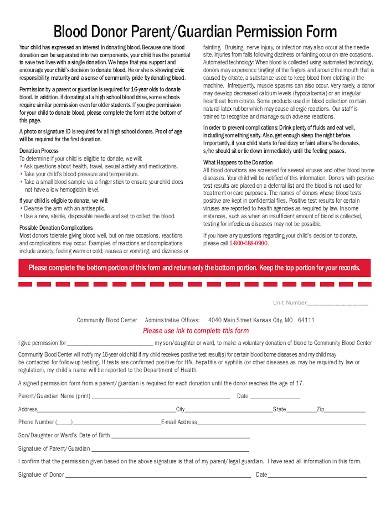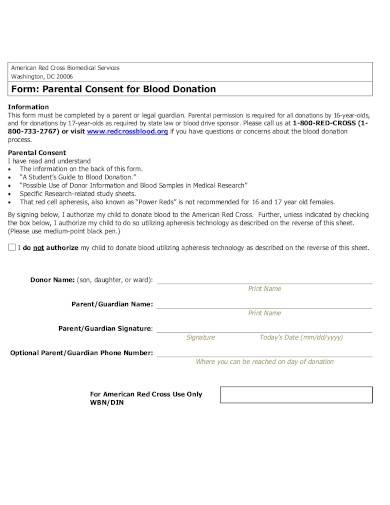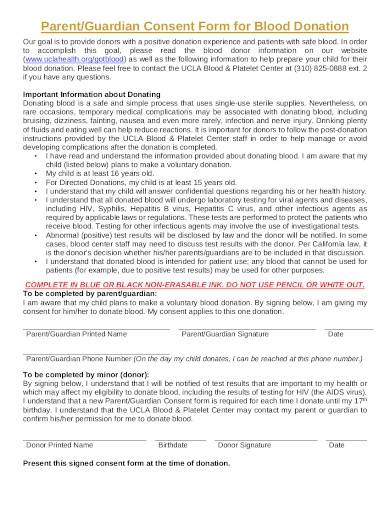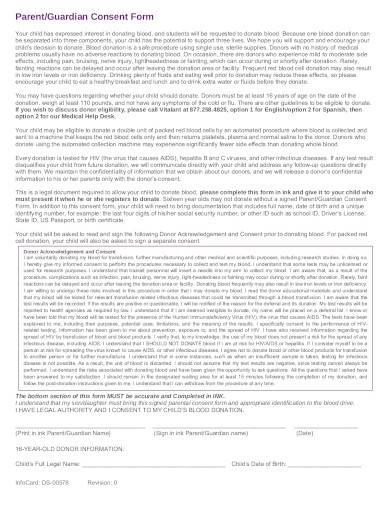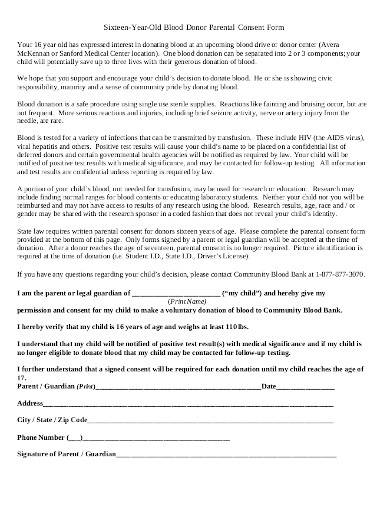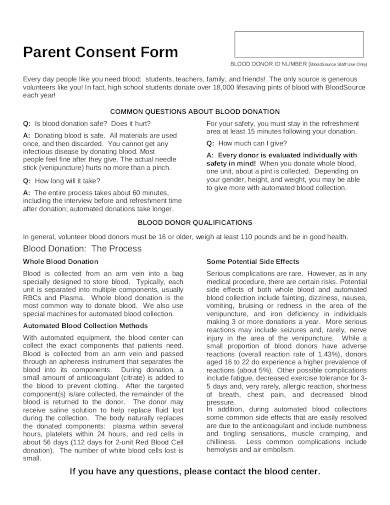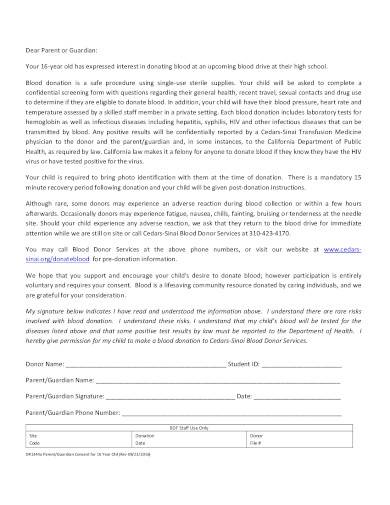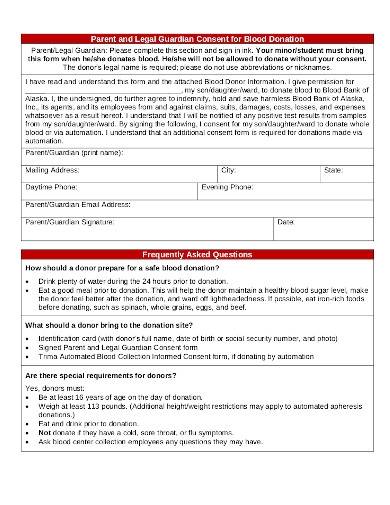Someone in the United States will need donated blood every 2 seconds. Hospitals like the Stanford Blood Center needs approximately 200 units of blood products each day. That is why blood donation is important. If a child wants to help humanity by donating blood, then parents should know of the documents to sign, such as a blood donor parent/guardian consent form. Read on to learn more about this essential document now!
FREE 10+ Blood Donor Parent/Guardian Consent Form Samples & Templates
1. Blood Donor Parent/Guardian Permission Form
2. Parental Consent for Blood Donation
3. Blood Donor Parent/Guardian Consent Form
4. Child Guardian Consent Form

5. Sample Parent /Guardian Consent Form
6. Blood Donor Parental Consent Form
7. Sample Parent Consent Form
8. Parental Consent Form for Blood Donation
9. Legal Guardian Consent for Blood Donation
10. Parent or Legal Guardian Consent Form
11. Sample Parent or Guardian Consent Form
What Is a Blood Donor Parent/Guardian Consent Form?
A blood donor parent/guardian consent form is a document that parents or legal guardians of minor blood donors need to sign before a minor can proceed with the blood donation. The purpose of a consent form is to make sure that the donor had the granted and legal permission from a guardian or parent. A consent form should state the details of the minor donor, and the contact information and signature of the guardian or parent.
How To Make a Blood Donor Parent/Guardian Consent Form
According to the American Red Cross, only 3% of the US population donates blood. Along with that, some blood types have fewer donors. That’s why it’s essential for donation agencies and organizations to inform donors and collect their information. And the best document for that is a blood donor parent/guardian consent form, which you can create easily by keeping the following tips in mind:
1. Add Details About the Blood Donation
A blood donor parent/guardian consent form must collect signatures and information and provide details about the blood donation activity. The details should include the process of the donation, the information disclosure or medical information release, and the tests required for the minor to complete.
2. Use Clear Fonts
Avoid using fonts that could be difficult to read, such as those which have styles or are cursive. Instead, choose regular fonts, including Times New Roman and Arial, and font sizes that are not too tiny for the human eye.
3. Collect Relevant Information
Do not require or collect pieces of information which are not necessary for documenting the consent. You must only collect those which are relevant, such as the parent’s contact information, the donor’s full name, and their residential address. On the one hand, if the consent form is for school-use, then you can collect the section or course and program of the donor, as well.
4. Know the Organization’s Preference
Most organizations have preferences in the specifications of their documents and forms, such as the file size and layout. That’s why you should know what your organization wants and needs. You can also add the banner or the letterhead of the organization at the top of the consent form. And, you can also add colors that show the organization’s branding and theme.
5. Choose a Use-Method
The method of using the blood donor parent/guardian consent form that you will make will depend on the procedure of the organization. That means, if your organization is electronically collecting details or conducting donor intake processes, then you will need an electronic fillable form, too! On the one hand, if your organization is into printing out documents, and physically filling it out, then you should format your consent form to be printer-friendly. For example, measure the margin and use the right paper size that suits your printer’s specifications.
FAQs
Can a parent or guardian still sign the blood donor parent/guardian consent form even if the child is against it?
The act of donating means willingly giving. If someone will be forced to make a donation, then it means it’s not a donation in the first place. But, when it comes to the medical and legal field, a parent or a person who has the legal guardianship of a child and minor can, indeed, sign a consent if needed. And one acceptable example is when the blood donation is a necessity for the minor’s well-being and if there’s an immediate need, such as during an emergency or if a family member needs the blood.
Is a blood donor parent/guardian consent form legally bearing?
It depends on the state and country. Some value a blood donor parent/guardian consent form to have a legal bearing, while others don’t, and others require further proof of parental consent. So, look up to the laws of your state about the legalities and requirements of consenting a minor to donate blood.
Is there a difference between a consent form to a medical authorization form?
Yes, there is a difference between the two forms. A consent form for minors will be more on documenting the approval or signature of the parent so that the child can proceed with a minor medical procedure. But, a medical authorization form will have even more detailed information and have a higher legal bearing than a consent. Some organizations and medical institutions use one of the two, while others use both for varying medical procedures.
Donating blood is beneficial for the donor, organization, and the receiving patient. However, it can also be harmful and risky for the donor, especially for minors. So, start making the consent form now with our free sample forms and templates above to document the consent of the donor’s parent and guardians right away!
Related Posts
FREE 14+ Permission Slip Samples in MS Word PDF
FREE 9+ Sample Video Consent Forms in PDF MS Word
FREE 10+ Medical Waiver Forms in PDF MS Word
FREE 9+ Sample Medical Consent Forms in PDF MS Word
FREE 9+ Sample Photography Consent Forms in MS Word PDF
FREE 5+ Sample Child Travel Consent Forms in PDF
FREE 9+ Sample Interview Consent Forms in MS Word PDF
FREE 10+ Tutoring Permission Form Samples in PDF MS Word
FREE 6+ Sample Survey Consent Forms in PDF MS Word
FREE 43+ Printable Medical Forms in PDF
FREE 7+ Sample Psychology Consent Forms in PDF MS Word
FREE 13+ Sample Medical Consent Forms in PDF
FREE 9+ Sample Survey Consent Forms in PDF MS Word
FREE 8+ Sample Parent Release Forms in MS Word PDF
FREE 43+ Sample Medical Forms in PDF

